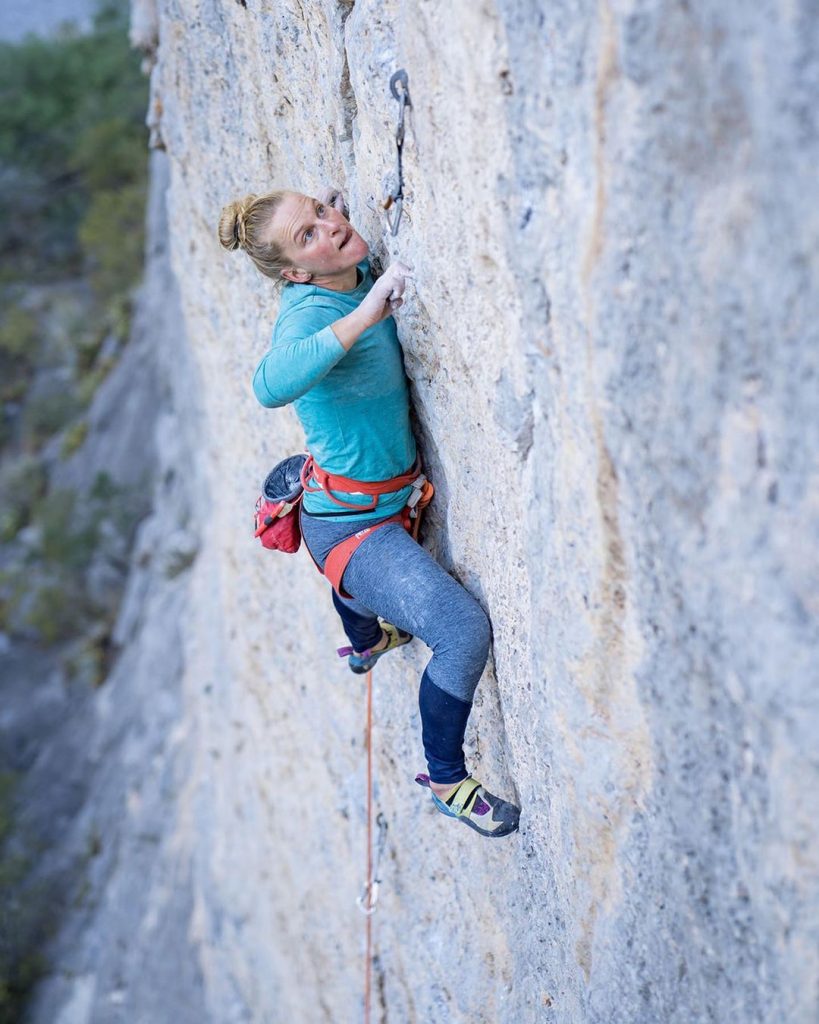Emily Harrington is an American rock climber. She is a five-time US National Climbing Champion and the first female climber to ascend multiple 5.14 sport climbs.
We caught up with her during the pandemic to talk about her career, life, injuries and lockdown.

Zushan Hashmi: How are you keeping busy during the COVID-19 lockdown?
Emily Harrington: I’ve been training a lot on my hangboard and I’m lucky enough to have a home wall as well (moon board and tread wall) for climbing.
Here, we can also go outside so we have been going on runs.
Other than that I’ve been trying to plan for the future and get strong for upcoming trips that may or may not happen.
Tell us a little bit about your life outside of climbing.
I live in Tahoe City, California with my boyfriend Adrian Ballinger (IFMGA mountain guide, professional big mountain climber, skier and owner of a guide company called Alpenglow Expeditions) and our dog, a 3-year-old Catahoula mix named Cat.
We spend a lot of time together when we aren’t on expeditions. We ski a lot in the winter and run in the summer and we just bought a house together so being home a lot during the pandemic has been a bit of a silver lining.
READ: John Brosler talks speed climbing, mental resilience and confidence
How did you start climbing? Share a little bit of that story with us.
I am originally from Boulder, Colorado and I grew up ski racing and doing gymnastics.
I discovered climbing on an artificial wall at a festival when I was 10 years old and begged my parents to let me do it again. I joined the local junior team at the gym after that and never looked back.
How do you compare traditional climbing and indoor sport climbing? Differences/similarities?
The amazing thing about climbing is that there is so much to explore with it. Indoor climbing is very controlled. It’s very safe, a great workout, and can be super social.
Outdoor sport climbing adds a bit more risk and required experience but it is still pretty close to indoor climbing (focused on the physical gymnastic movement and the bolts are already in the rock ready to use).
Traditional climbing involves placing one’s own protection - in the form of cams or nuts and sometimes other things - that is later removed. Most of the time you are climbing cracks (which is where the gear is placed).
It’s a bit scarier and requires more experience and knowledge of how to use the gear and when, and therefore can be more dangerous.
Then there is the element of multi-pitch climbing (going more than one rope length up the wall), big wall climbing (multi-pitch but usually sleeping on the wall), alpine climbing (involving rock and ice), mountaineering (involving snow & winter camping) and high altitude mountaineering.
There’s a lot of differences between all the disciplines; physically, logistically and risk-wise, but what they often share is a love for movement in the mountains in some way (i suppose with the exception of indoor climbing).
I personally love indoor climbing though because I think it is the best way to stay and shape and get stronger for outdoor climbing projects.
Tell us about your expeditions and ascents?
I’ve explored all the different styles of climbing - from indoor competitions to high altitudes and even some skiing. I’ve been on World Cup podiums, climbed 5.14b sport routes, free-climbed El Capitan (big wall trad), summited Mt Everest, and summitted and skied Cho Oyu (6th tallest peak in the world).
I really enjoy mixing up all the different styles and I think it makes me a better athlete and keeps it interesting.
How does mountaineering differ from climbing in terms of skill, technique and abilities?
For sure it is more dangerous, requires different skills and physical fitness (more endurance than power) but having a solid rockclimbing background is always helpful when it comes to technical climbing, exposure, and understanding the systems.
For me, it is often not technically as difficult as rock climbing but requires a level of suffering and risk management that you do not encounter on a rock.
What sort of training goes into climbing and mountaineering, and what works for you in particular?
For climbing I do a lot of specialized training in the gym: bouldering, hangboard, campusing, some yoga.
For mountains, I usually am just trail running or backcountry skiing.
What has been one of the toughest routes that you have climbed to date, and why?
It depends on the style but I have sport climbed a few 5.14b’s. Sport climbing is really mentally difficult because you essentially have to be perfect in order to succeed.
It’s like a performance that you must rehearse over and over again until you can do it perfectly (without falling).
Whereas the mountains are much more based around external factors (weather and conditions) but involve a lot more physical suffering so that too can be mentally hard.
Challenging yourself at the highest level is no easy job, and it requires a lot of mental strength and ability, how do you work on your mindset and mental health during preparations?
I try to focus on the things I can control and let go of the things that I can’t.
I work really hard to train so that I can go into a project knowing I did everything I could to prepare. I also try to take proper rest - which is super important but often overlooked by athletes.
What sort of training goes into climbing regularly, and what works for you in particular?
I do a lot of bouldering and hangboarding. I think it forms a really good base for all kinds of climbing. If I have a big wall or mountain objective I mix in some running as well.
I am naturally more of an endurance athlete and not as good at pure power so I tend to focus a lot on power because it is what I am weak at.
Your fall at Yosemite has been covered by several media outlets, could you tell us a bit about how you overcome something like that and build the resilience to continue climbing?
I hope I can overcome it. I think for me I just realized that I wasn’t being conservative enough in the situation for the conditions (humid and early morning).
It was an unfortunate mistake but I accept that in rockclimbing those things happen. I hope I can go back to Yosemite soon and try and work through the trauma of it, mentally and get past it.
I think it will just take a bit of time.
READ: Angy Eiter: Elite climbing in Austria and overcoming injuries
It is well understood that in most sports you have to understand your body and how it reacts to different situations, how important is understanding your mental health when it comes to climbing?
Just like anything, mental strength is probably more important than physical. If you do not believe in yourself or trust your abilities you cannot perform well.
What do you say to young women and athletes who want to get involved in the sport, especially considering young people often feel it is a dangerous sport, or do not really understand the safety procedures around it?
Climbing can be as safe or as dangerous as you make it. Going to a climbing gym is 100% controlled and very safe and I recommend anyone try out a gym for their first time. It’s a wonderful sport with a place for everyone.
What do you have coming up in the future, once we are all back outdoors and climbing regularly?
I would like to make it to Yosemite once it’s open and it feels safe to do so.

